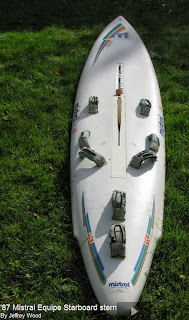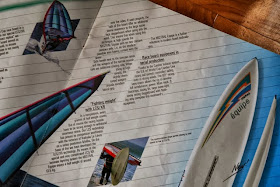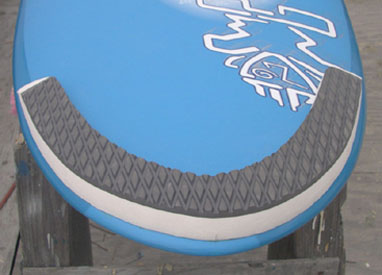)-: My CAT is dying :-(

If you were looking for Mistral Equipe II , I have one of those as well - 2016
http://joewindsurfer.blogspot.ca/2016/04/mistral-equipe-ii2.html
I was NOT ready for the KONA ONE nor the new expensive Starboard Phantoms, RS D2's etc ...
Finally found a Mistral Equipe I LCS-XR in Sudbury & Dr.Windsurf was going to Toronto/GTA.
LCS means Light Compound System and I am unsure what XR stands for - so far ...
Perhaps Xtreme Racing ?? :-) Actually found out what XR stands for in my '83 '84 '85 Mistral brochure. They call it "extra reinforced". Apparently it has the lightest components/materials with extra layers of laminate. Carbon fiber, lighter, high resistance, etc, etc :-)
Let's see how they compare before I go into a lengthy analysis and / or comparison ...

--------------Fanatic Ultra CAT --------------------------- Mistral Equipe LCS-XR
--------------374 cm long ----------------------------------------372 cm
---------------66 cm wide -----------------------------------------65 cm
--------------210 litres--------------------------------------------210 litres
--------------13.2 - 16.6 kg --------------------------------------13.5 kg
--------------keel 63 cm carbon --------------------------------62 cm fibreglass ??
--------------fin 30 cm --------------------------------------------32.5 cm
--------------1990 ?? ---------------------------------------------1986
this came after the Equipe I apparently
On paper they look VERY similar. However, everyone feels upon first look that the Mistral looks much smaller. It is definitely lighter - and so, the CAT is closer to the 16 kilo figure. The keel or centre board of the CAT is carbon and much wider chord/width - it sticks out of the board when raised whereas the Mistral does NOT. Here is the Mistral one:
In the next pic we see the Mistral centre board lying on the Fanatic's. This shows the slight difference in length, butt major difference in chord or width ...
The fin that i received with the Equipe is a Tinho Dornellas fin and a profile i have never seen. It is a larger fin that is very light and yet has carbon and fibers ...
Both are supposed to be A-box aka US box and yet the Mistral is different $%^&*(
Zose crazee Germans :-) {i was born in Hamburg :-) }
The way the mast base attaches and slides is very different also. The Mistral simply pops in and turn the plate - et voilà !!
The CAT has a lock pin and the track locks on one side with a finite number of positions - about five , while the Equipe has ten markings, but with the rope setup seems to stop anywhere you want.
The Equipe has four concaves and the literature boasts that only two touch when planing making this a really early planer - around 10 to 12 knots.

The CAT has a double Vee with concaves and planes well also.
The CAT does NOT tack well - will see how the Equipe goes ...
Received the Equipe yesterday and so far ...
have sealed the front of the board and the seam using Sikaflex 291 marine sealant
sanded the keel/centre board
started putting new foot straps on ... RRD - sorry Mistral AND RRD :-)
tried to figure out what to do with mast foot - or make a board with a hole to push against for downhauling
the extension does NOT easily come apart
Windance sells this "sliding bolt" that fits under the sliding track to take a Chinook base
obviously reduces the adjustment on the fly :-)
the board looks and feels good and i cannot wait to try it - in light and mid winds :-)
====================================================================
I started looking for where i could get that nut for the track and costs thereof ... It was about $16 everywhere and about $20 shipping $%^&*( And so, I analysed WHAT could i do myself instead !! Why was the nut 2.5 cm wide when my track is 1.5 cm wide?? Made a steel plate with a hole with dimensions of 1.5 cm by 4 cm and checked for fit. It was OKAY,
butt how to turn it under the mast base AND in the track ??
My finger would NOT fit under the mast base in the narrow track #$%^&*( and THEN i realized why and how the nut could be 2.5 cm with a 1.5 cm track #$%^&*()_ Ocean Air Sports warned me that i had to take the track out. Well, that is NOT what i wish to do... I would like to keep the track as is AND have the option of using a "modern" mast base ...
And SO, i came up with a new design... I made a steel plate of 3 cm by 17.5 cm / 7 inches with a hole to accept the mast base bolt. So, now how to get the nut under the plate ?? AND ensure it did not turn during tightening ?? Well, i DID it !!!
Put two(2) popsicle sticks together with electric tape. Put that at the bottom of the track using needle nose pliers. Placed the nut on the sticks using the pliers. Then pressed the plate on top of the nut in order that it would NOT move. The mast base bolt was screwed into the nut and the popsicle sticks removed. To be able to tighten it properly, electrical tape was placed on the plate around the hole to keep the nut from turning. Naturally, the board HAD to be level !!!
And now the board is ready to test with a properly downhauled sail !!
All i need now is some wind - 20 kph would be GR8...
Also, the fin was such a strange design i actually wondered which side was front :-) It seemed logical and yet the shape is just so weird for me !!! In any case , it went on the logical way and is really far back on the board !!! Should be great for manoeuvring ... Dr Windsurf had said he used tape to tighten the fin in the box. There was enough crap left in the fin box to keep it tight now !!! Will leave it as is for now ...
=====================================================================
Before I forget ... Dr. Windsurf gave me the original pamphlet from Mistral with many of their products including the Equipe... Here are some snappies:

Let's see if zooming and turning lets us read it a bit better !!
SUN 29SEPT2013 - finally took my Mistral Equipe out on her maiden voyage - for me that is ... Weather had potential for winds up to 20 kph, butt was NOT even close. The road to OKA had two(2) major traffic jams and just as many major accidents - it was apple pickin' season after all !!
As usual, I used my MS-oh 8-oh. Winds were way too light - well under 10 knots ... The board glides well and i needed some time to adjust to a differently cluttered deck - as opposed to the CAT. Also was NOT used to the way the board bobbed when chop and swell came from the side. It did NOT take long and i was used to it and was doing light wind jibes and tacks with NO issues. The mast track slid once - will have to check that out. Bad traffic, light wind, mast track slid - cannot give the session more than a 7 outta 10 - even IF it was a beautiful day !!! I cannot wait to try the board in mid winds - around 10 to 12 knots - compared to today's 3 to 5 @#$%^&*(
As i was finding the board crowded while getting used to it, I have removed the two side foot straps - the ones for upwind tilting. Once i get more comfortable with the board they will be put back ...
SUN 06OCT 2013 - winds were to be from the NE at 20 to 40 kph. Rain was to happen in the afternoon. Where and when to go ?? Decided to go to OKA at the main beach in the morning bringing both the Mistral Equipe longboard and the AHD. Wanted to test the Mistral and so rigged the MS-oh 8-oh to go with the long board. The board goes upwind well with that fin - like Tinho Dornellas alluded.. The board planes very well and going downwind with the waves and current gave a very special feeling. I had difficulties tacking and actually had better luck gibing !! Tacking was somewhat better when i dropped the centre board. The issue was waves, current and wind all from the same direction - like what happens at Pointe-Claire. This board planing does NOT feel like a freight engine planing - like the Fanatic Ultra CAT does and i would say i like the Mistral better in such winds. I stayed closer to shore to stay out of the bigger winds and to test the long board - as Georges said.
Others were out with 8.x sails too, butt with 130 to 140 liter boards. Pierre was the exception with a 98 litre board and a 6.5 Ezzy wave sail !!
Session was a 7.5 outta 10 -NOT bad for 2nd time out on the board !! in less than ideal conditions ...
SUN 13OCT2013 - had decided the next outing would be with the sliding mast track ie original mast base and i was hoping for wind today...I cannot believe i was gonna figure out how to rig the base at the site !!! I tried rigging the MS-oh 8-oh in the back yard and i had misery - translated from french :-) I could not haul it down further than this:
which left the leech tight, but worse than that, the battens stuck out past the mast :-(
and the nice straight lines in the downhaul belie the issues i had getting the cleat to hold the line. Also, the wood piece with the hole was used against the base in order to have something to push against without breaking the universal joint or base "/$%?&*() And so, i decided to try and move the slider up the extension and see what we come up with. The downhaul was much better for the battens and i even managed to pull too much in terms of the leech and next time will add the blue collar that i had removed in order to be closer to the bottom for 6 cm extension.
and here is the loose leech
this may be okay for gusty winds and control, but with the long board one prefers a little less leech. With less downhaul, that is how i busted my battens that ride with the cambers :-( I think I now like better sails with no cambers when i ride a long board. So far my favourite size is 8-oh cuz that is what i have. However, in KONA class the size is 9-oh for heavy weights and so, i imagine one day i will be riding my long boards with a 9-oh ... However, besides the SW Retro , i would be surprised if there are many windsurf sails with 9.0 square meters and NO cambers !!! Maybe go back to the MS Pursuit 8.5 one day...
I also just discovered that the KONA class allows 9.8 sails for riders over 98 kilos.
My weight is usually 95 to 100 kilos !!!
I have used the TR-4 10-oh with the CAT and enjoyed it, but NOT in bigger winds !!!
With the Equipe I received an old booklet on windsurfing and my middle son recently found one for free in French too. In one of these books or on the web, I saw a pic of someone downhauling with the mast base attached to the board. Perhaps i will try that one day ...
The season is pretty much over for the warm days and who wants to longboard in the cold ??
Oddly enough, I could find NO videos with the Equipe I LCS-XR. There are some with the Equipe II and the Equipe RACE LCS One Design. Will post some here and eventually make my own. What i am pondering now is: how to get the mast attachment working !!!
This one looks like the MOD - Mistral One Design RACE. On this one you can see how much the board could ride OUT of the water. Both show decent speed in light winds...
Since there are NOT very many videos about this Mistral Equipe board, I will make some.. Here is my first attempt at describing the board. I will redo it in daylight. The GoPro seems to prefer bright daylight ...When i tried one in the evening under artificial light, it did NOT come out at all !!!
And now in morning light - attempt number 3 - also changed saturation using youtube.
In May 2014 I finally ran my first clip of the board in action. Here it is light wind - around 10 to 12 knots with an 8-oh. In just a little more wind, like 12 to 15 knots, this board is supposed to be in its element. I will try document what works best with the MEQ...
Took the MEQ out at OKA Parc north of Montreal. The water was really HIGH and so there was NO beach and DEEP. This means less room for error. Especially when the water was "wavy". Should not have tried the race sail with the MEQ on such a day. Here is a clip of the best 8 minutes. Sucky session with bad tacks - gotta get out there more. These videos help me see where to stress improvement. Move back, etc..
Update SEPT 2014:
I have always avoided rigging the original mast extension because i thought the base would not come off. Some images on iwindsurf gave me some courage and so I made some attempts at taking the bottom apart. The screws seems to do nothing because the pulley held it together. What about the cauter pin? Well, that DOES separate the mast base from the extension and NOW i can rig it with my foot applying downhaul in the standard fashion. This gives me more courage to try the sliding track ... Here is the pic:
An anonymous commenter gave this GREAT link with photos of the different Equipes:
http://www.hostingpics.net/viewer.php?id=372598mistralequipemodels.jpg
Think this is the better windsurfing clip with this board - need to push the skills !!
Move mast track back and get in straps !!!
Use videos for self analysis:
In 2016 I also purchased a Mistral Equipe II/2
Here is the discussion / link:
http://joewindsurfer.blogspot.ca/2016/04/mistral-equipe-ii2.html
and am trying to sell the MEQ One for a mere $300 after getting the original centreboard back from Franco... This board is too good to sell

Sold BOTH the Mistral Equipe One and the Fanatic Ultra CAT in early 2016. These were my two favourite longboards to date. Let's see how the MEQ II does ... on the water that is !!
In the same year, there is a fellow out of Ottawa selling a MEQ One with 372 length and 235 liters. He calls it the XR version ONLY - no LCS and from 1993. What surprises me is the bottom shape:
 |
| WHY OBX ?? |
Not four concaves like my MEQ One nor vee like my MEQ 2. How many different Mistral Equipe's are there then ??
































